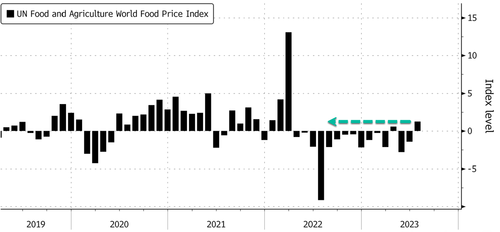World Food Prices Jump Most In 18 Months
Image Source: Unsplash
Global food prices increased the most in one and a half years as trade disruptions from the El Niño weather phenomenon battered agricultural-producing countries. Additionally, Russia's exit from a crucial UN-backed agriculture deal stoked supply concerns.
The Food and Agriculture Organization of the United Nations (FAO) reported on Friday that the global food index, which tracks monthly changes in the international prices of globally-traded food commodities, averaged 123.9 in July, up 1.3% from the previous month.
The FAO Food Price Index's July print was the largest monthly gain since March 2022.
The FAO explained that the FAO Vegetable Oil Price sub-component of the index was responsible for the monthly increase:
"The increase was driven by a sharp jump in the FAO Vegetable Oil Price Index, which rose 12.1 percent from June after seven months of consecutive declines. International sunflower oil prices rebounded by more than 15 percent in the month, due mostly to renewed uncertainties surrounding the exportable supplies after the Russian Federation's decision to end implementation of the Black Sea Grain Initiative. World prices for palm, soy and rapeseed oils increased on concerns over output prospects in leading producing countries."
Also, the FAO All Rice Price Index increased 2.8% on the month and 19.7% on the year due to how "India's 20 July prohibition of non-parboiled Indica exports fostered expectations of greater sales in other origins, amplifying upward pressure already exerted on prices by seasonally tighter supplies and Asian purchases," the report said.
This upward pressure on rice prices "raises substantial food security concerns for a large swathe of the world population, especially those that are most poor and who dedicate a larger share of their incomes to purchase food," the FAO warned.
We noted in April and in early May, "El Niño Watch Initiated As Ag-Industry In Crosshairs," and "Global Rice Shortage Looms, Set To Be The Biggest In Decades," as a disruptive El Niño weather pattern wreaked havoc on the world's agricultural crops. Rising food prices risk fueling social instability for the weakest emerging market economies.
More By This Author:
Seasonal Adjustments Turns $38BN Bank Deposit Outflow Into $5BN InflowAmazon Makes Sweeping Overhauls Of Grocery Business To Compete With Walmart, Kroger
Dollar & Bond Yields Tumble After 'More Or Less Benign' Payrolls Print
Disclosure: Copyright ©2009-2023 ZeroHedge.com/ABC Media, LTD; All Rights Reserved. Zero Hedge is intended for Mature Audiences. Familiarize yourself with our legal and use policies ...
more





